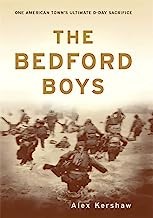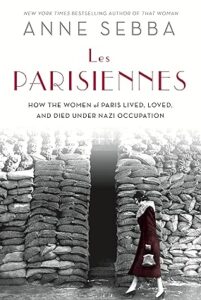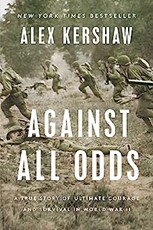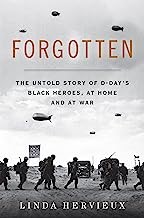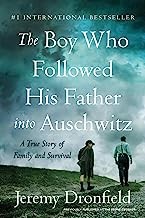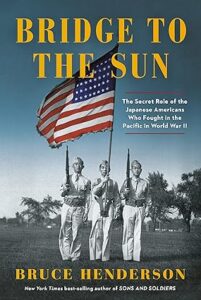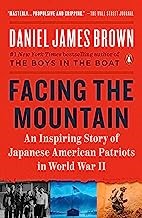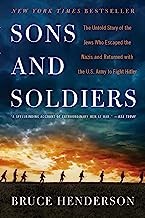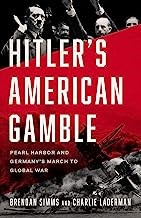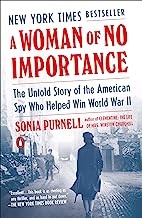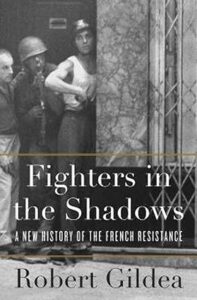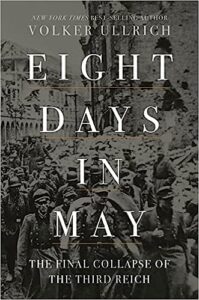NAZI AMERICANS PARADE IN FORCE IN NEW YORK CITY
New York City, New York • October 30, 1939
On this date in the Manhattan borough of New York City hundreds of American Nazis paraded in front of the headquarters of the German American Bund (Amerikadeutscher Bund; bund means “alliance” in English). Among German speakers, Bund members, and fascist supporters the organization was simply “Bund.” Carrying the Stars and Stripes, the Bund flag, and the German national flag, the swastika, and preceded by a marching band, thousands of uniformed Bund members and fans lined both sides of the street for blocks in support of German Fuehrer Adolf Hitler’s declaration of war against Poland (quickly vanquished), Great Britain, and France just 9 weeks before. For the German American Bund, fascist sympathizers, and conceivably for bystanders that day too, Nazi Germany’s launch of a global war justified a big parade.
German immigration played an important role in populating the United States. Over 7.2 million Germans had settled largely in urban areas between 1820 and 1920. Port cities along the East Coast had large German-speaking populations. Midwestern cities like Chicago, St. Louis, Cincinnati, and Milwaukee were favorite destinations too. So were Texas and the West Coast. Germans fleeing economic and political disorder in their country during the 1920s increased the German American population in New York City to 683,338. By 1938 New York City had the third largest German-speaking population in the world. Thus New York City was the logical nursery for ethnic, cultural, social, and political associations, including right-wing groups that promoted favorable views of Nazi Germany. The German American Bund was the largest of these groups, founded in 1936 in New York, but it built on the success of the Friends of the New Germany, founded in 1933 in New York City in a merger of two earlier organizations by German immigrants supporting Nazism and Hitler’s Third Reich.
The leader (Bundesfuehrer) of the German American Bund was Fritz Julius Kuhn, a German-born U.S. citizen (as of 1934). Geographically, the Bund divided the U.S. into 3 regions (Gaue) and 69 local branches (Ortsgruppen), the administrative model being Nazi Germany. As might be expected, Gau Ost (East) had 40 local branches with the majority (17) in New York state, followed by Gau Midwest (19) and Gau West (10). The Bund established a number of training camps that also served as summer youth camps (see photo essay below). The camps were sites for rallies replete with Nazi insignia, troops marching in crisp uniforms practicing their Hitler salute and Heil Hitler-ing everybody, and much ranting against the administration of President Franklin D. Roosevelt, Jewish American groups, “Jewish-controlled” media, communism, “Moscow-directed” trade unions, and American boycotts of German goods. For youngsters and youth there were outdoor summer activities like picnicking, swimming, canoeing, hiking, singing around the campfire, archery and rifle practice blended with generous helpings of Nazi ideology, Aryan (white) supremacy, and anti-Semitism—all for a weekly cost of $4.00 per person.
The year 1939 was the best of times and the worst of times for Bundesfuehrer Fritz Kuhn. Convicted of tax evasion, forgery, and embezzlement ($14,000 from the Bund), Kuhn was sent upriver to New York state’s Sing Sing Prison on December 6, 1939, to begin serving his sentence. While there his 1934 U.S. citizenship was revoked owing to his status as a foreign agent of the Nazi government, and with that he was transferred to a federal internment camp in Texas as a dangerous enemy alien. Other leading Bundsmen were also interned, others jailed for various offenses. After the war Kuhn was deported to Germany and died at age 55 in Munich in 1951. As for Kuhn’s German American Bund, by 1940 it was on life support, its programs under intense government scrutiny and its precious camps as a consequence suffering significant drops in attendance and activities. Dispirited Bund stalwarts returned to Germany. The Bund’s Untergang came when it was officially disbanded days after the bombing of Pearl Harbor, Hawaii, and Germany’s declaration of war against the United States on December 11, 1941.
![]()
The German American Bund and Its Summer Youth Camps on the Eve of World War II
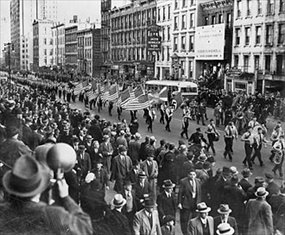 | 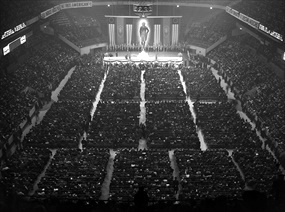 |
Left: Carrying U.S. and swastika flags, American Nazis parade down East 86th Street, one street up from the national headquarters of the German American Bund at 178 East 85th Street in Yorkville, commonly referred to as Germantown, on Manhattan’s Upper East Side on October 30, 1939. Although not officially part of Hitler’s National Socialist (Nazi) Party, the Bund acted as if it were. Even their official attire approximated German Nazis right down to brown shirts and leather jackboots. Bundists had to hold American citizenship. Paradoxically, for all the media and popular attention the Bund attracted during its heyday, precise membership figures are guesstimates, ranging from 25,000 dues-paying Bundists to as low as 6,000.
![]()
Right: An all-white crowd estimated at 20,000–22,000 American Nazi activists and enthusiasts from all over the country attended the German American Bund’s heavily guarded “Pro-American Rally” at New York’s old Madison Square Garden at Eighth Ave. and Fiftieth St. on Monday, February 20, 1939. Behind center stage was a 30‑ft-tall portrait of George Washington, claimed as an icon by the Bund, which called him “the first Fascist” and asserting Washington “knew democracy could not work.” The keynote speaker was the bumptious 43‑year-old Bundesfuehrer Fritz Julius Kuhn dressed in his usual gray and black paramilitary uniform. Kuhn was a former German infantry officer in World War I, a womanizer, an alcoholic, and a petty thief, the latter trait leading to his repeated arrests in his native Germany. (See YouTube video below.) All during the rally scuffles occurred outside the indoor arena where 10,000 or more anti-Nazi and so-called “Jewish militia” protesters massed, occasionally rushing the cordon of 1,700 tear-gas-armed policemen in attempts at forcing entry, only to scuffle with Kuhn’s busy stormtroopers once inside the auditorium. Kuhn, who spoke English with a thick German accent and whom the media nicknamed the “vest-pocket Hitler,” was himself the target of a punch when a 26‑year-old unemployed Jewish plumber attempted to attack him on the rostrum as he launched into an anti-Semitic harangue. Kuhn’s strong-arm men came to his rescue. The riotous “Garden Party” made national and international headlines.
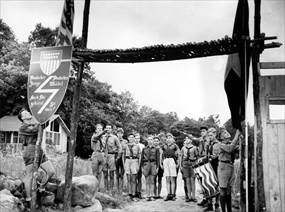 | 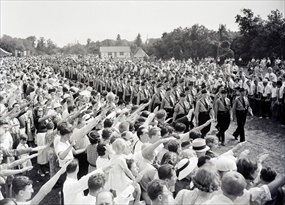 |
Left: Youths at Camp Nordland, a German American Bund camp in Andover Township, New Jersey, stand at attention as the American flag (left) and the German American Youth Movement flag (right) are lowered in a ceremony at sundown on July 21, 1937, four days after the camp was opened. A sign in the form of a shield to the right of the troop of boys contains a sig rune (or Siegrune, which roughly equates to “Victory Letter”) and the words “Deutscher Junge, Deutsches Maedel, Auch Du gehoerst zu uns!” (German boy, German girl, you are one of us!). From 1937 to 1941, the Bund’s 204‑acre resort camp on the shore of MacDonald Lake played host to Italian-American fascist leaders and held joint rallies with the Klu Klux Klan. In April 1941 a Sussex County sheriff and 10 deputized American Legionnaires descended on the camp, which resulted in its closure and confiscation. In time the camp became the township’s “Hillside Park.”
![]()
Right: Thousands of German Americans give the Nazi salute to columns of young men marching down Adolf Hitler Strasse in crisp Hitler-esque brown shirts, black ties, Sam Brown belts, and dark trousers. The event celebrated German Day and took place at Camp Siegfried, the German American Bund’s camp near the bucolic village of Yaphank in Suffolk County, Long Island. German Day festivities drew 40,000 attendees in August 1938 according to the New York Times. An impressive presence of some 2,000 uniformed members of the Bund’s paramilitary Ordnungsdienst (police service) provided security. Camp Siegfried was 50 miles from New York City. Every Sunday during the summer the Long Island Rail Road ran a Camp Siegfried Special that carried many hundreds of Bund members, Nazi admirers, and sundry fascists from New York’s Penn Station to Yaphank.
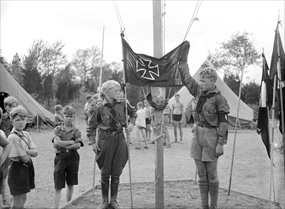 | 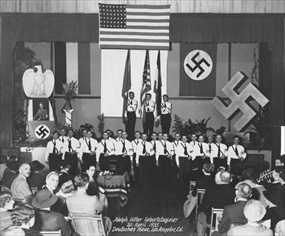 |
Left: The boys in this photo are campers at Camp Wille und Macht (Will and Power) at Griggstown, New Jersey, in 1934. The boy on the right holding up the Iron Cross flag is wearing a sig rune armband. On the flagstaff behind the Iron Cross flag hangs a portrait (partially hidden) of Paul von Hindenburg, Germany’s president from 1925 to his death, age 86, in 1934. It was Hindenburg who reluctantly appointed 43‑year-old Adolf Hitler to the chancellorship on January 30, 1933, following a series of electoral victories by Hitler’s Nazi Party. For more stories on Nazi summer camps in the U.S. (there were eventually 21 camps coast to coast), click here.
![]()
Right: Bund members and Nazi admirers on the West Coast celebrate Hitler’s 46th birthday at the Deutsches Haus hall, restaurant, and tavern on West Fifteenth St., Los Angeles, on April 20, 1935. A color guard carrying the American flag, the Bund flag, and the German national (swastika) flag take center stage. Under the large German eagle (left in photo) is a photo of Hitler in military uniform. Birthday festivities included a film show and a good old-fashioned torchlight parade attended by more than 2,000 people.
German American Bund Rally, Madison Square Garden, New York City, February 20, 1939
![]()

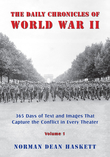 History buffs, there is good news! The Daily Chronicles of World War II is now available as an ebook for $4.99 on Amazon.com. Containing a year’s worth of dated entries from this website, the ebook brings the story of this tumultuous era to life in a compelling, authoritative, and succinct manner. Featuring inventive navigation aids, the ebook enables readers to instantly move forward or backward by month and date to different dated entries. Simple and elegant! Click
History buffs, there is good news! The Daily Chronicles of World War II is now available as an ebook for $4.99 on Amazon.com. Containing a year’s worth of dated entries from this website, the ebook brings the story of this tumultuous era to life in a compelling, authoritative, and succinct manner. Featuring inventive navigation aids, the ebook enables readers to instantly move forward or backward by month and date to different dated entries. Simple and elegant! Click 